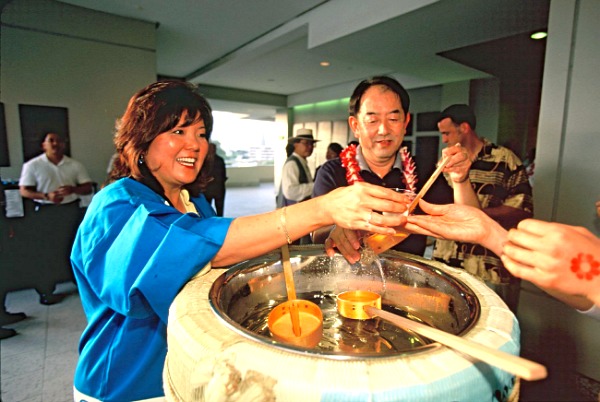East Asia Correspondent
Osaka, JP - Japanese traditional sake had a resurgence in 2011, with drinkers consuming 23% more than in 2010. After hitting a peak in the mid-1970s, consumption gradually fell to a third. Last year, though, saw a return of enthusiasm for sake as a way of supporting Tohoku, a region with three major sake-producing prefectures: Miyagi, Fukushima and Iwate. Tohoku is also the site of the major disasters that occurred in March 2011.
Now, sake has become fashionable once again as a way of helping out a disaster-ravaged part of the country and returning to Japanese culture.
As the saying goes, it is an ill wind that does not blow someone some good. Sales for sake from those hard-hit prefectures have gone up by 5 percent for Fukushima, 14 percent for Iwate and 28 percent for Miyagi, according to the National Washoku and Sake Foundation.
Specialty izakaya devoted to the rich variety of sake from the Tohoku region have sprung up in major cities like Tokyo, and it appears almost every drinking spot in the country offers more sake than ever before.
New brands are starting to call themselves fukkoshu, or restoration sake. Suddenly, Japanese seem to have rediscovered a beverage with roots in Japan's earliest recorded history.
It was not too long ago that Japanese-style bars and restaurants started stocking foreign alcohol, and it became acceptable to sip wine at that most traditional of Japanese undertakings: sakami, cherry-blossom viewing parties.
The interest in all things foreign is unlikely to reverse itself entirely, but the Sake and Shochu Makers Association, which tracks sales and consumption, reports that Japanese drinks are making a comeback. Sake lovers call it "drinking revival support".
The affordability of foreign alcohol after import tariffs were reduced in the 1980s was perhaps less a factor in sake's decline than other countries' drinks appearing exotic, sophisticated, and best suited for a trendy meal in a chic restaurant. Sake became tagged as a cheap drink for overworked "salarymen" drinking in low-priced bars. Young people shunned it and older people wanted something new.
Much has changed since then. Nowadays, sake is served at the finest French restaurants in Paris. Women, whose entry to sake breweries was long considered taboo, started to become master brewers and sake sommeliers.
Sophisticated and high-priced varieties were developed, and specialty shops and restaurants throughout the country became more knowledgeable about how to pair sake with French, Mexican, and Southeast Asian cuisine.
New types of sake were developed, even low-calorie sake for the diet-conscious. General knowledge of how sake is made has been better dispensed.

The consumption of sake is helping a region of the country desperate for income and attention, and is helping to rehabilitate the image of sake in important ways.
To nondrinkers, that may sound like just another excuse for more tipple. However, according to the Japan Sake and Shochu Makers Association, 93 of the 114 breweries in the three quake-affected prefectures of Iwate, Miyagi and Fukushima were seriously affected by the earthquake and tsunami.
Most breweries suffered extensive damage to brewing equipment and facilities, others had products and storerooms washed away, while others lost skilled employees.
When faced with such devastation, the sake industry received great support from across the country. Yamasaki Hiro, a supervisor for a local brewery in Chiba, believes both young and old are taking a renewed interest in sake. "All kinds of people are returning to drinking sake from all parts of the country," Yamasaki mentioned to Le Prestige. "Sake festivals last year were crowded with drinkers eager to taste new varieties and raise a cup to their recovery. It's very Japanese."
Investment firms have started to offer shares in Tohoku breweries to help them back on their feet. The revival of sake in Japan is an example of how profoundly the Tohoku earthquake has changed Japanese hearts and minds.
Japanese people are becoming more interested in their culture and how unique Japanese products, like sake, appear to the international community.
In the rush to appear international, Japanese have forgotten their own traditions and some were left aside in favor of the new and different. Sake, though, like rice from which it is made, remains close to the heart of Japanese culture.
Satou Chihiro, a business woman in Osaka, approves of the sake trend. "Sake brewing and consumption is a traditional industry that many feel deserves protection, support and attention," Satou stated. "The rejuvenation of sake will hopefully be the first in a wave of similar renewals."

















 RSS Feed
RSS Feed





